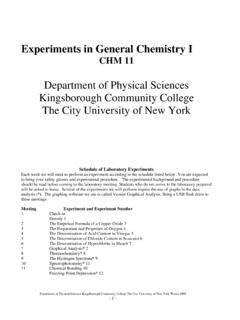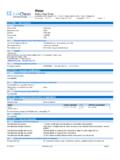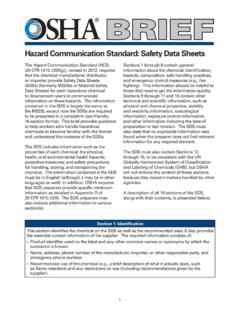Transcription of Quality Control of Compounded Radiopharmaceuticals
1 ::VOLUME 15 (XV), LESSON 3::. Quality Control of Compounded Radiopharmaceuticals Continuing Education for Nuclear Pharmacists And Nuclear Medicine Professionals By Vivian S. Loveless, , BCNP, FAPhA Associate Professor Department of Pharmaceutical Sciences College of Pharmacy The University of Tennessee Health Science Center The University of New Mexico Health Sciences Center, College of Pharmacy is accredited by the Accreditation Council for Pharmacy Education as a provider of continuing pharmacy education. Program No. 0039-0000-09-150-H04-P Contact Hours or .35 CEUs. Release date: 9/14/2009 Expiration date: 9/14/2012 (will be extended an additional 3 years upon initial expiration date) - Page 2 of 34 - -- Intentionally left blank -- - Page 3 of 34 - Instructions: Upon purchase of this Lesson, you will have gained access to this lesson and the corresponding assessment via the following link < > To receive a Statement of Credit you must: 1.
2 Review the lesson content 2. Complete the assessment, submit answers online with 70% correct (you will have 2 chances to pass) 3. Complete the lesson evaluation Once all requirements are met, a Statement of Credit will be available in your workspace. At any time you may "View the Certificate" and use the print command of your web browser to print the completion certificate for your records. NOTE: Please be aware that we cannot provide you with the correct answers to questions you received wrong. This would violate the rules and regulations for accreditation by ACPE. We can however, tell you which question number(s) you received wrong. You may contact the CE Administrator to request this information. Disclosure: The Author does not hold a vested interest in or affiliation with any corporate organization offering financial support or grant monies for this continuing education activity, or any affiliation with an organization whose philosophy could potentially bias the presentation.
3 - Page 4 of 34 - Quality Control of Compounded Radiopharmaceuticals By Vivian S. Loveless, , BCNP, FAPhA Editor, CENP Jeffrey P. Norenberg, MS, PharmD, BCNP, FASHP, FAPhA UNM College of Pharmacy Editorial Board Stephen Dragotakes, RPh, BCNP, FAPhA Michael Mosley, RPh, BCNP Neil Petry, RPh, MS, BCNP, FAPhA James Ponto, MS, RPh, BCNP, FAPhA Tim Quinton, PharmD, MS, FAPhA S. Duann Vanderslice, RPh, BCNP, FAPhA John Yuen, PharmD, BCNP Advisory Board Dave Abbott, RPh, BCNP Dave Engstrom, PharmD, BCNP Mark Gurgone, BS, RPh Scott Knishka, RPh, BCNP Lisa Marmon, RPh, BCNP Brigette Nelson, MS, PharmD, BCNP Janet Robertson, BS, RPh, BCNP Samuel Ernesto, RPh, MBA Brantley Strickland, BCNP Director, CENP Kristina Wittstrom, MS, RPh, BCNP, FAPhA UNM College of Pharmacy Administrator, CE & Web Publisher Christina Mu oz, UNM College of Pharmacy While the advice and information in this publication are believed to be true and accurate at the time of press, the author(s), editors, or the publisher cannot accept any legal responsibility for any errors or omissions that may be made.
4 The publisher makes no warranty, expressed or implied, with respect to the material contained herein. Copyright 2009 University of New Mexico Health Sciences Center Pharmacy Continuing Education -Page 5 of 34- Quality Control OF Compounded Radiopharmaceuticals STATEMENT OF LEARNING OBJECTIVES: Upon successful completion of this CE lesson, the participant should be able to discuss the general concepts and processes associated with the Quality Control procedures of Radiopharmaceuticals . Specifically, the participant should be able to: Upon successful completion of this lesson, the reader should be able to: 1. Discuss the various types of Quality Control procedures involved in the compounding of Radiopharmaceuticals and the importance of each. 2. Understand the principles of radiochemical purity testing.
5 3. Select the proper media and solvents for radiochemical analyses. 4. Determine the appropriate counting instruments to use for radiochemical analyses. 5. Define the steps necessary in developing and validating an alternate procedure to that prescribed in the manufacturer s package insert. 6. Identify potential pitfalls in radiochemical testing that could lead to false results. 7. Explain the principles of radionuclidic purity testing. 8. Discuss the potential pitfalls in performing radionuclidic purity testing. 9. Describe the procedures for performing Quality Control for a chemical contaminant. 10. Describe procedures for identifying pharmaceutical concerns. 11. List Quality Control procedures for Positron Emission Tomography Radiopharmaceuticals . -Page 6 of 34- COURSE OUTLINE INTRODUCTION.
6 7 Quality Control PROCEDURES .. 7 PRINCIPLE OF RADIOCHEMICAL PURITY ANALYSIS .. 7 RADIATION DETECTION INSTRUMENTATION .. 13 WELL SCINTILLATION COUNTERS .. 13 DOSE CALIBRATORS .. 13 RADIOCHROMATOGRAM SCANNERS .. 14 DEVELOPMENT OF ALTERNATE PROCEDURES FOR RADIOCHEMICAL TESTING .. 14 PITFALLS IN DETERMINATION OF RADIOCHEMICAL PURITY 2,13,28-30 .. 15 PRINCIPLE OF RADIONUCLIDIC PURITY Quality Control .. 17 PRINCIPLE OF CHEMICAL PURITY .. 18 PHARMACEUTICAL CONCERNS .. 20 20 PARTICLE SIZE AND NUMBER .. 20 PH .. 22 IONIC STRENGTH, ISOTONICITY, AND OSMOLALITY .. 22 Quality Control FOR POSITRON EMISSION TOMOGRAPHY Radiopharmaceuticals .. 23 RADIONUCLIDIC PURITY .. 23 RADIOCHEMICAL PURITY .. 23 CHEMICAL PURITY .. 24 PH .. 24 STERILITY .. 25 BACTERIAL ENDOTOXIN TEST .. 25 SUMMARY .. 25 REFERENCES.
7 26 ASSESSMENT QUESTIONS .. 30 -Page 7 of 34- Quality Control OF Compounded Radiopharmaceuticals Vivian S. Loveless, , BCNP, FAPhA Associate Professor Department of Pharmaceutical Sciences College of Pharmacy The University of Tennessee Health Science Center INTRODUCTION A radiopharmaceutical is only as good as the care taken in each preparation step throughout the compounding process. With diagnostic Radiopharmaceuticals it is important to have a product with acceptable Quality Control (QC) parameters in order for the nuclear medicine study to be effective yet deliver unnecessary radiation exposure to the patient. However, with therapeutic Radiopharmaceuticals it is mandatory to satisfy the guidelines for Quality Control because otherwise, the results could be life-threatening to the patient.
8 Quality Control PROCEDURES These procedures include tests for radiochemical, radionuclidic, and chemical purity as well as checks for pharmaceutical concerns. Some of these tests are performed by the manufacturers, while others must be performed by the compounding personnel. The emphasis of this article will be on the Quality Control tests performed by the compounding personnel. Official requirements for the Quality Control standards can be found in the manufacturer s package inserts, the United States Pharmacopeia (USP), and Nuclear Regulatory Commission (NRC) regulations; however, a licensee must always adhere to standards established in the radioactive materials license under which they are working. Quality Control procedures should always be performed following radiopharmaceutical preparation and prior to patient administration to ensure optimal radiopharmaceutical product.
9 PRINCIPLE OF RADIOCHEMICAL PURITY ANALYSIS Radiochemical purity (RCP) of a radiopharmaceutical is defined as the percent of the total radioactivity present in the desired chemical form in a radioactive Without acceptable RCP in a diagnostic radiopharmaceutical, image interpretation can be compromised which can result in a delay of an accurate diagnosis and unnecessary radiation exposure since the nuclear -Page 8 of 34- medicine study must be repeated. With a therapeutic radiopharmaceutical, an unacceptable RCP can lead to the radiopharmaceutical localizing in an unintended target, which may result in organ damage. In clinical practice, the RCP analysis must be quick, accurate, and economical whereas in a research environment greater emphasis is placed upon accuracy, while the time and economical factors are sometimes less important.
10 In the case of Positron Emission Tomography (PET) Radiopharmaceuticals which are characterized by a short half-life, time is more critical. Keep in mind that the solvents used can be potentially hazardous and must be properly stored and handled in accordance with local, state, and federal regulations. With regard to traditional technetium 99mTc Radiopharmaceuticals , the three types of radiochemical impurities to be determined are as follows: free technetium 99mTc pertechnetate (99mTcO4-), hydrolyzed-reduced 99mTc (insoluble 99mTc dioxide and/or 99mTc tin colloid), and bound 99mTc to the ligand of interest (desirable radiochemical form).2 All of impurities can be determined using a chromatography system, consisting of a stationary phase and a mobile (solvent) phase. For certain newer technetium 99mTc Radiopharmaceuticals , a fourth type of radiochemical impurity may be present as well: 99mTc labeled to other (secondary) chemical compounds ( , the hydrophilic species in 99mTc exametazime)3 or transfer ligands ( , 99mTc tartrate in 99mTc-mertiatide,4 and 99mTc gluconate in tetrofosmin)5.









